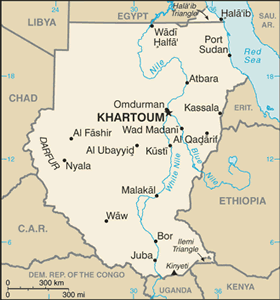The Geography of Sudan
The Geography of Sudan
Sudanese Geography
Location: Northern Africa, bordering the Red Sea, between Egypt and Eritrea
Geographic coordinates: 15 00 N, 30 00 E
Map references: Africa
Area: total: 2,505,810 sq km land: 2.376 million sq km water: 129,810 sq km
Area - comparative: slightly more than one-quarter the size of the US
Land boundaries: total: 7,687 km border countries: Central African Republic 1,165 km, Chad 1,360 km, Democratic Republic of the Congo 628 km, Egypt 1,273 km, Eritrea 605 km, Ethiopia 1,606 km, Kenya 232 km, Libya 383 km, Uganda 435 km
Coastline: 853 km
Maritime claims: territorial sea: 12 nm contiguous zone: 18 nm continental shelf: 200 m depth or to the depth of exploitation
Climate: tropical in south; arid desert in north; rainy season varies by region (April to November)
Terrain: generally flat, featureless plain; mountains in far south, northeast and west; desert dominates the north
Elevation extremes: lowest point: Red Sea 0 m highest point: Kinyeti 3,187 m
Natural resources: petroleum; small reserves of iron ore, copper, chromium ore, zinc, tungsten, mica, silver, gold, hydropower
Land use: arable land: 6.78% permanent crops: 0.17% other: 93.05% (2005)
Irrigated land: 18,630 sq km (2003)
Natural hazards: dust storms and periodic persistent droughts
Environment - current issues: inadequate supplies of potable water; wildlife populations threatened by excessive hunting; soil erosion; desertification; periodic drought
Environment - international agreements: party to: Biodiversity, Climate Change, Climate Change-Kyoto Protocol, Desertification, Endangered Species, Hazardous Wastes, Law of the Sea, Ozone Layer Protection, Wetlands signed, but not ratified: none of the selected agreements
Geography - note: largest country in Africa; dominated by the Nile and its tributaries


